Reviewing hardware is an act of minutia. Occasionally something new or potentially earth-shattering comes along, but on the whole, it’s about chipping away. Documenting small, gradual changes designed to keep product lines fresh and — if you play your cards right — differentiating yourself from the competition.
Apple’s as guilty of this as anyone, of course. That’s just the nature of a 12 to 24-month product cycle. Every refresh can’t be a revolution. Every so often, however, a game-changer comes along — something undeniable that sets the scene for a more profound shift for a product line. The trio of Macs launched at the company’s third major press conference in three months certainly apply.
It’s been 15 years since Apple made the jump to Intel processors from PowerPCs, a chip technology it had relied upon for more than a decade. That move came as the company was butting up against the limitations of its chosen technology. PowerPC took them far at the time, but it couldn’t deliver on the processing power it desired for the next generation of portables.
As with that transition, the move toward Apple silicon has been years in the making. The company has been making a concerted effort to wean itself off of third-party components. Among other things, it’s increasingly difficult to differentiate your product when you’re essentially using the same parts as everyone else on the market. Creating your own processors is, of course, a long and difficult process. Thankfully, however, the company had a head start.
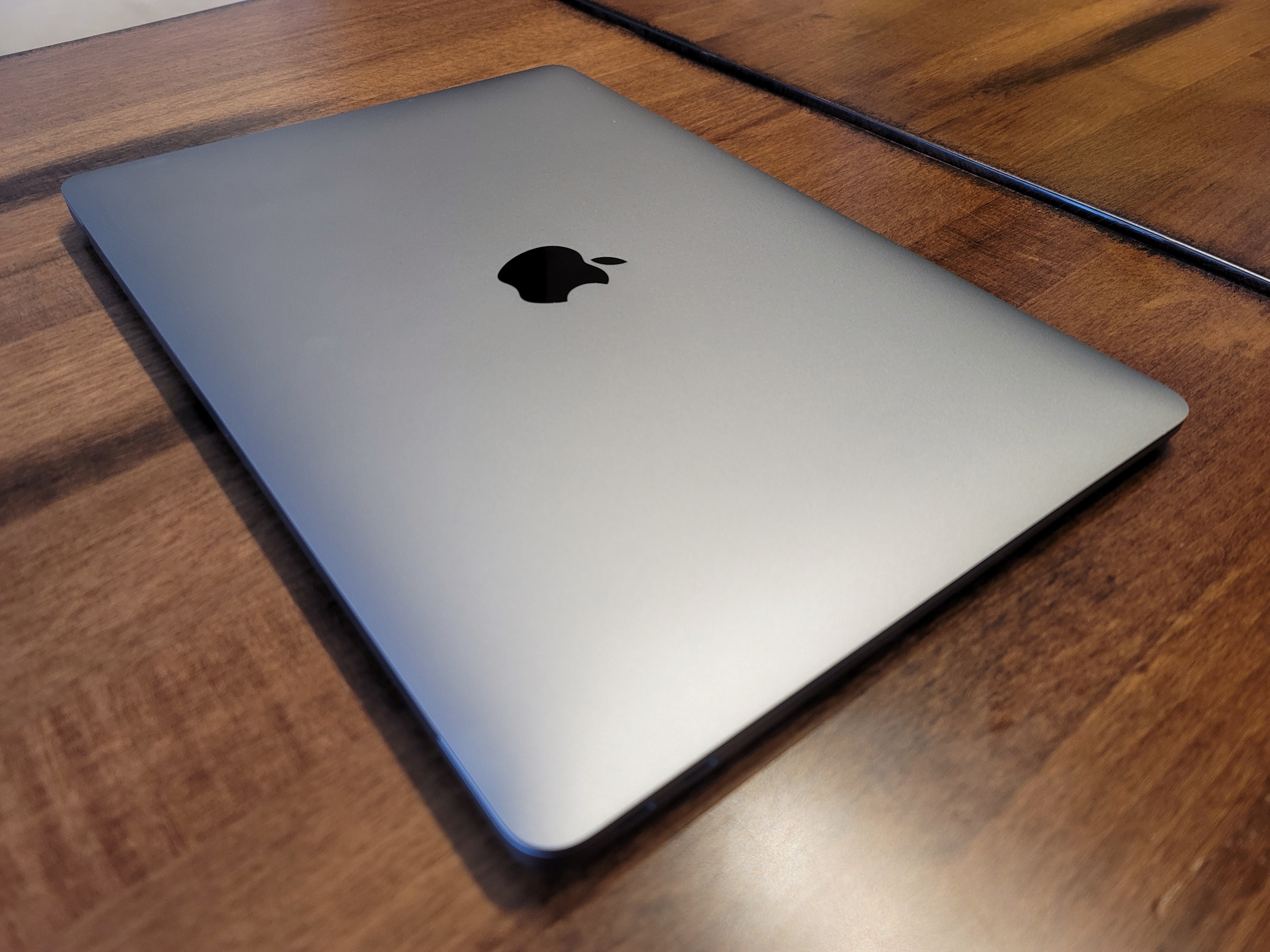
Image Credits: Brian Heater
The Arm-based chips that power the company’s mobile devices are a great starting point. The company can build on several generations of learning, while moving ever closer to that perpetual Holy Grail of Apple software: perfect cross-ecosystem compatibility. Elements of iOS have been trickling down into MacOS for years now (a trend that includes, and arguably accelerates with, Big Sur), while the company eased the transition for Intel Mac owners with the Catalyst.
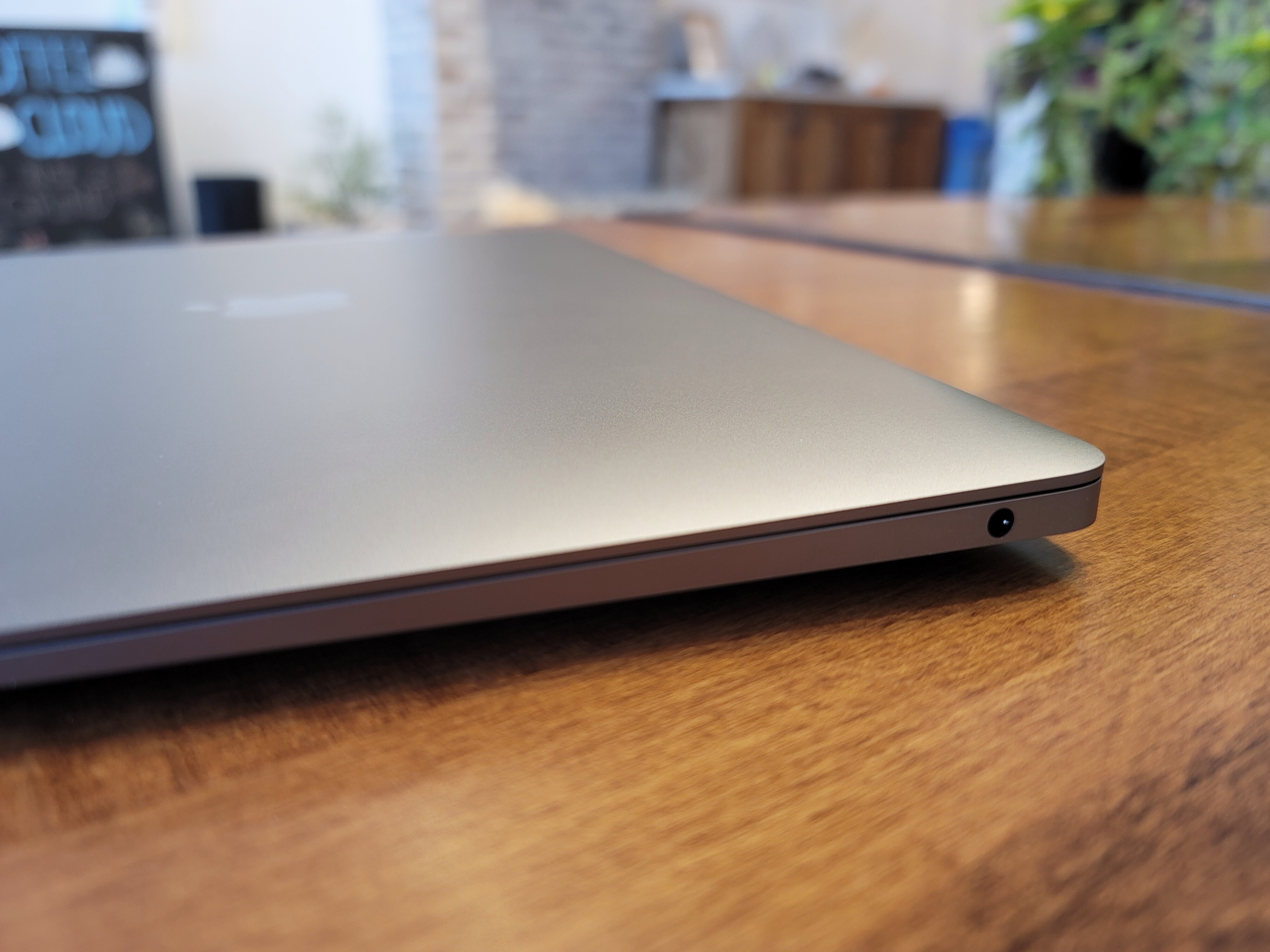
Image Credits: Brian Heater
After countless rumors and months of wait, the first three Apple Silicon Macs are finally here. And the results are, in a word, impressive. You’ve no doubt seen some of the benchmarks that have popped up over the past several days that have left many in the community taken aback. While it’s true that Apple talked up performance in its own presser, it’s easy enough to discount those numbers without more specific benchmarks. We’ve split our testing of the three systems among three editors — and it’s pretty safe to say we were blown away by what the systems can do.
Okay, so, a brief break down of the M1:
- Eight-core CPU with a stated 2x performance gain
- Seven- or eight-core GPU (depending on the Air model you go in for) with up to a 2x graphical upgrade
- 16-core neural engine
- Increased power
- Improved image signal processing
The Air, in particular, presents some truly robust gains of the most recent versions of the system, released back in March. That may feel like forever ago, given everything that has transpired, but that’s a mere eight months. The system excels at two benchmarks in particular: battery life — measures by a simple video playback — and Geekbench, which tests a system’s CPU and GPU performance by simulating real-world situations. Anecdotally, things are just faster all over the place.

Image Credits: Brian Heater
Apps open almost instantly and resource-intensive tasks like editing 4K video are surprisingly zippy. Some of these are changes you’ll likely notice right away, even if you’re not pushing the system to the limit. Take the neat trick of waking up instantly from sleep. It’s something we’ve taken for granted on mobile devices but haven’t seen as much on desktops.
These advances, perhaps unsurprisingly, arrive in the same package. Like the new Mac mini and 13-inch Pro, the Air is identical to the one released early this year. Perhaps the company is seeking to maintain consistency on the outside as the products undergo rather dramatic changes under the hood. Maybe a redesign didn’t line up with the move to Arm. Or, hey, maybe Apple thinks the current design represents some sort of platonic ideal for thin and light laptop.
Whatever the case, you’d be hard-pressed to pick the new Air out of a lineup. I’ve been using the system in public, and no one’s been any the wiser that I got a slight head start on the next generation of Macs. If I’m being honest, I’d have liked it if Apple had ushered the moment in with some befittingly dramatic redesign — but at least no one can accuse Apple of introducing change for the sake of change. And let’s be honest, while the physical design of the Air hasn’t changed much in recent generations, it remains one of the most iconic and better-looking laptops on the market.
That includes the same thin and beveled design that differentiates the product from the rest of the MacBook line, and at 2.8 pounds, it’s 0.2 pounds lighter than the 13-inch MacBook. That’s not a huge spread, but it’s something that will make a difference to your lower back over time — I say that as someone who lugged the system around on a 15-mile walk over the weekend.
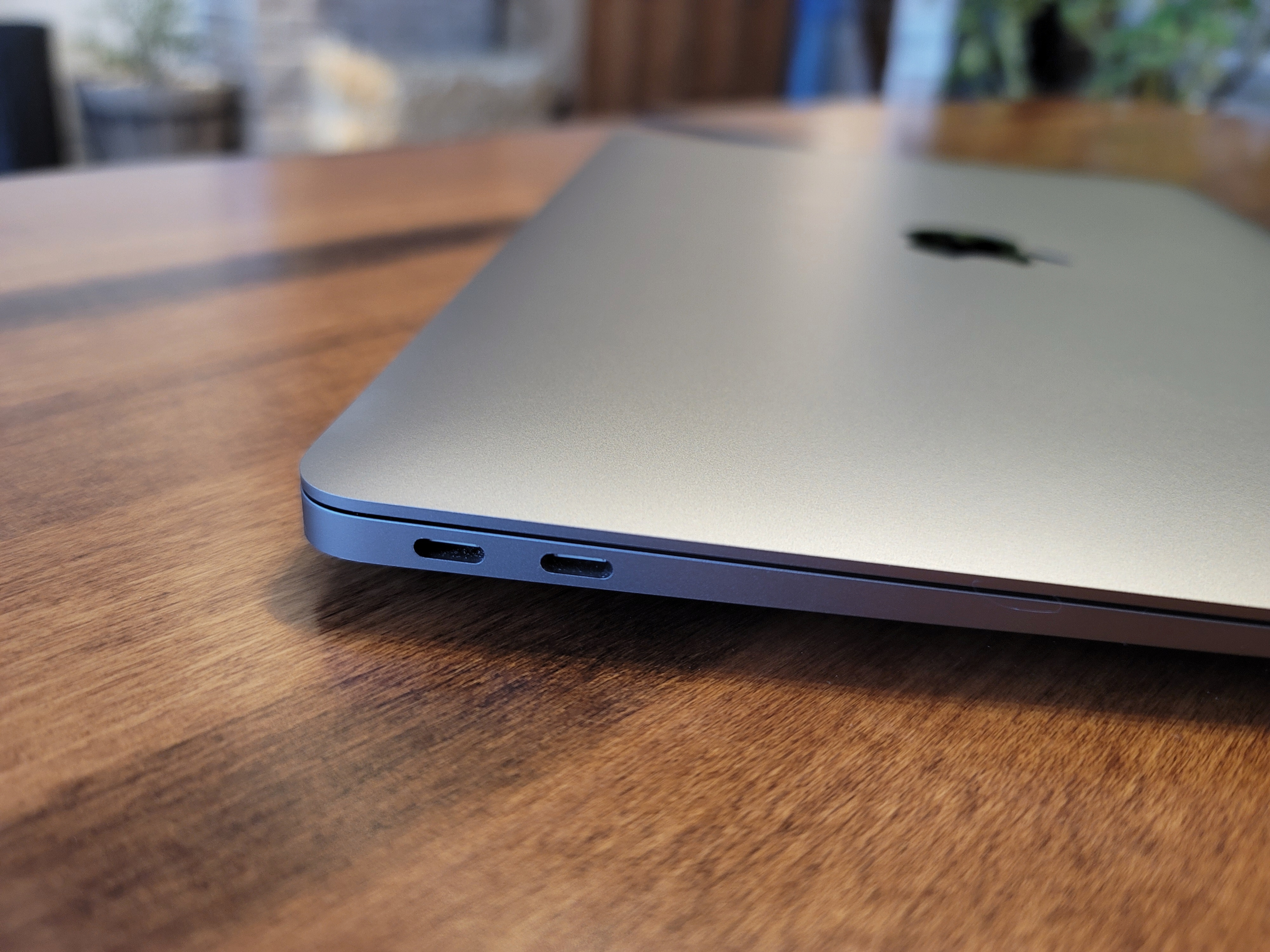
Image Credits: Brian Heater
Once again, there are two USB-C ports, both positioned on the same side. I’m always going to argue for more ports, especially given the fact that one will semi-regularly be monopolized by a charging cable. I’m also a fan of spreading them out a bit more — preferably on either side of the machine for those instances when you just can’t get enough slack from the cable or have something a bit wider plugged into the port. Of course, there’s no surprise on that front, unlike the new 13-inch Pro, which lost two ports in the process of upgrading.
That will likely sting for some users attempting to figure out whether to upgrade here. The change appears to be connected to some limitations of the new M1 SOC. If I was a betting man, however, I would suggest that there’s a pretty reasonable possibility that whatever pro-focused version of the chip comes next will support more ports for upcoming devices like the first Apple Silicon 16-inch MacBook Pro.
In fact, the company is likely reserving a number of upgrades to differentiate this round from some new pro-focused devices likely to arrive at some point next year. It’s all part of a kind of configuration of Apple’s Mac strategy that we’re seeing play out in slow motion. The new Air, 13-inch MacBook Pro and Mac mini represent the entry-level tier for the Mac line. It’s a category that’s become an increased focus for the company in recent years — and one we’ve seen play out across the iPhone and Apple Watch lines.
There is, of course, still truth in the longstanding notion of the premium “Apple Tax,” but the company has expended its approach to improve things on the lower end. One of the more surprising aspects of this strategy on the Mac side is just how much the company has closed the gap between the MacBook Air and 13-inch MacBook. There are differences between the two devices, of course. For many or most, the biggest is the $300 price gulf between the $999 starting price for the Air and $1,299 13-inch MacBook Pro.
So, how does Apple justify the price difference? And more to the point, will the upsell make a difference for a vast majority of users? Before we go any further, let’s break down the key differences between the new Air and Pro.
- Stated Battery – Pro: Up to 20 hours, Air: Up to 18 hours
- Display – Pro: 500 nits of brightness, Air: 400 nits
- Microphone Array – Pro: Studio-quality three-mic array, Air: Three-mic array
- Touch Bar – Pro: Yes, Air: No
- Speakers – Pro: Stereo speakers with high dynamic range, Air: Stereo speakers
- Fan – Pro: Yes, Air: No
The last bullet is the most important when it comes to performance. The arrival of the M1 made a fanless MacBook Air a possibility — something that was unheard of in early models. It bodes well for the thinness of future MacBooks, and more immediately, it means extremely silent performance. And, indeed, no matter how much stress testing I’ve managed to do over these past few days, the system has remained eerily silent — though I’d caution you that the passive cooling system can result in a rather toasty Air if you really push things. And, more importantly for a workload standpoint, the system will throttle during resource-intensive tasks — but you’ll have to push it.
Take, for example, the five-minute, 8K clip we exported in Final Cut Pro. At 33:13 minutes on the Pro and 32:59 minutes on the Air, the end result was, honestly fairly negligible (the Mac Pro, meanwhile, blew them both away at a blazing five and a half minutes). Ditto for running a WebKit compile. That took 25 minutes and five seconds on the Air and 20 minutes and 43 seconds. That’s not entirely negligible, but both systems beat out the 2019 16-inch MacBook Pro’s 26 minutes and 56 seconds. And both systems took far less of a battery hit, losing around 9% during the process, versus the 16-inch’s 39%.
The new M1 chips are remarkably energy efficient, even when performing more resource-intensive tasks. In a video playback test, I got 16 hours of life. That’s less than the maximum 18 hours stated by Apple’s numbers, but it’s an impressive figure, nonetheless. I would certainly feel comfortable leaving the house without a charge.
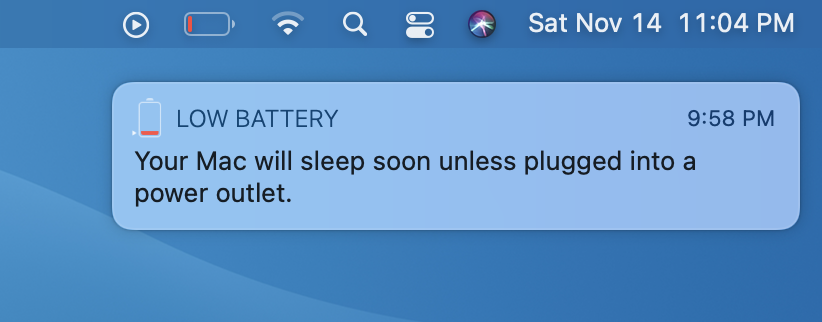
Per Matthew’s numbers, the Pro fares even better. He was able to get right around the stated 20 hours. That higher figure likely comes due a higher capacity battery courtesy of the thicker laptop footprint. In both cases, however, the systems blew away last year’s 13 and 16-inch Pros, which got eight hours and eight minutes and six hours and 40 minutes, respectively. That’s a tremendous bump in an important metric.
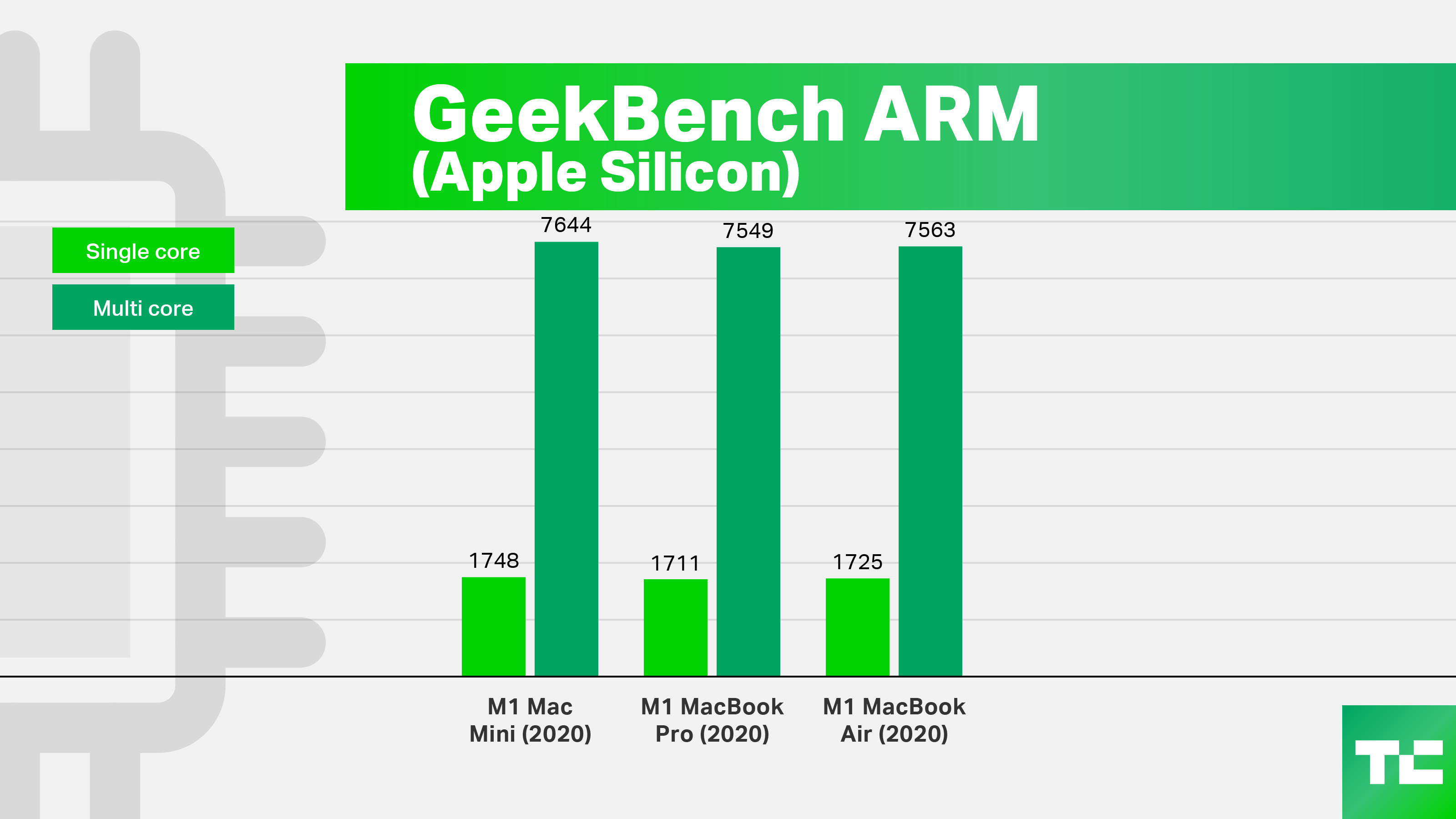
Image Credits: Bryce Durbin
So let’s break down those Geekbench 5 numbers. The new Air and Pro’s numbers are quite similar. That’s to be expected given their respective internals. Again, you’re going to have to really push the system — likely for a prolonged amount of time — before the Air take a noticeable hit due to its fanless design. The Pro scored a 1711 on single core and 7549 on the multi-core. The Air got an average of 1725 and 7563, respectively (for good measure, I’ll add that the the Mini hit a similar 1748 and 7644).
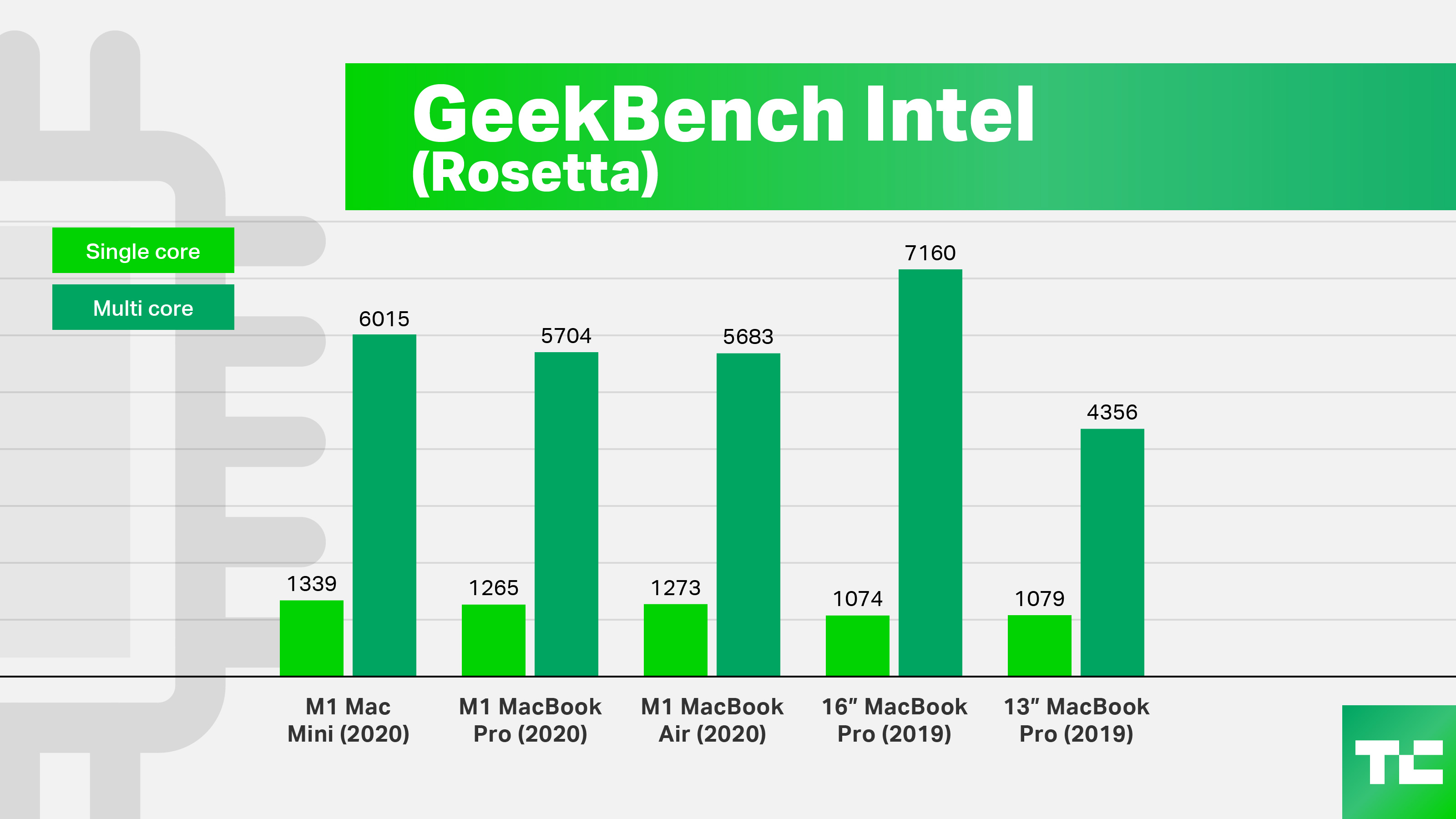
Here’s some more historical context from Geekbench. A few relevant examples: the Core i7 MacBook Air from earlier this year averaged 1136, while the 13-inch Pro hit 1240. Running the Intel version of the benchmark (using the Rosetta 2 emulator), the numbers predictably took a hit, but still best the Intel systems. And, indeed, Intel-designed apps performed quite smoothly.
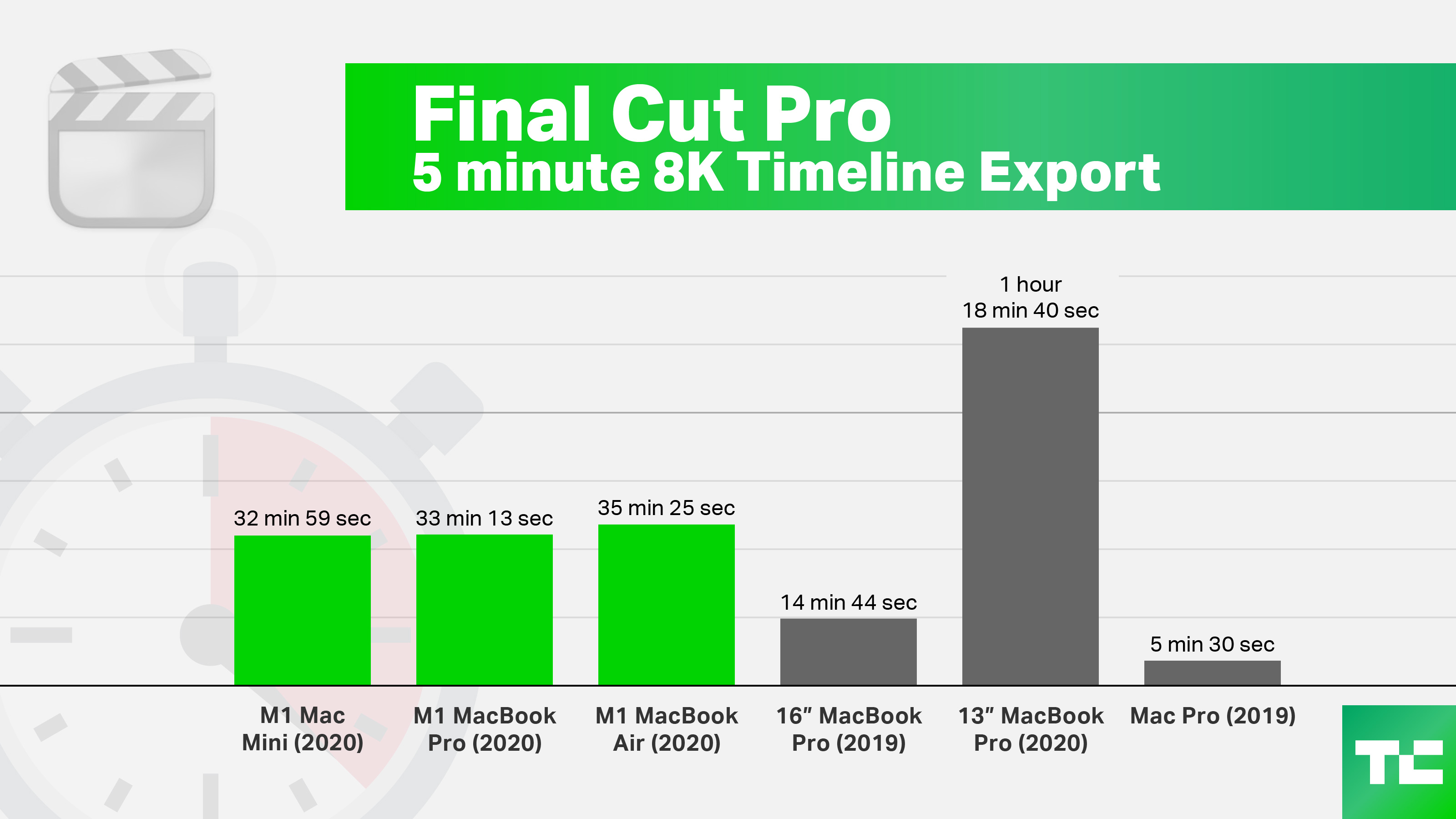
Image Credits: TechCrunch
Most of the benchmarks we ran found the two systems scoring remarkably close to one another. In other words, I think it’s a safe bet a majority of people searching for systems at this tier won’t be bumping up against those kinds of limits too often. Those who do find themselves frequently performing tasks that challenge those hardware limitations are going to have the difficult choice of buying the new 13-inch Pro now or waiting the see what models like the 16-inch have in store. For more information on that front, spend some time with Matthew’s review of the new 13-inch.
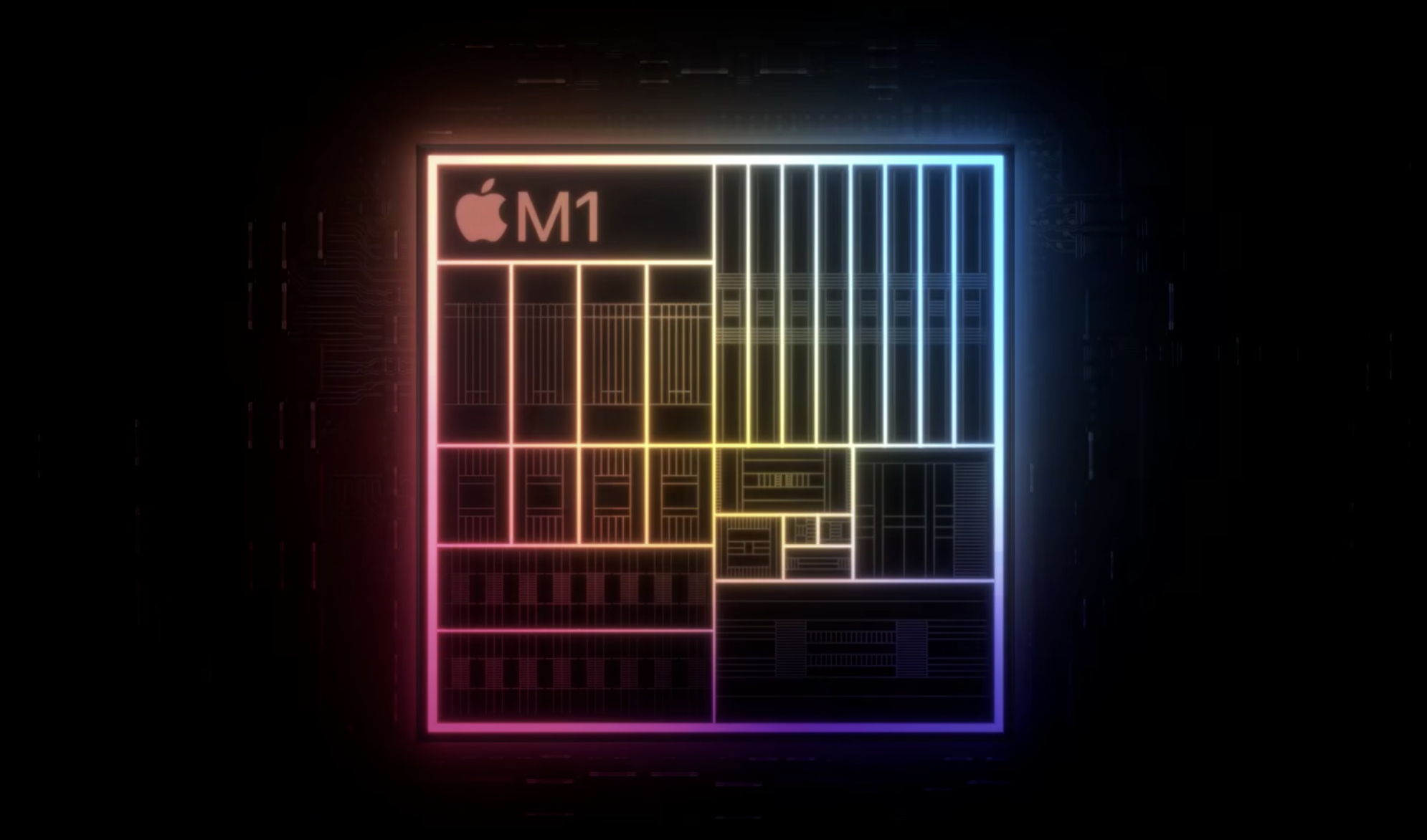
Image Credits: Apple
What I can say with more certainty, however, is that Apple’s got a much stronger case for its rediscovered focus on creative pros. While the category has long been its bread and butter, a case can be made that the company has surrendered some of that market to the likes of Microsoft’s Surface line and others. Apple made the case that the Touch Bar found it rekindling that relationship, but I think there’s a much stronger case to be made for a MacBook Air that can process much heavier workloads than its predecessors.
And, frankly, I haven’t missed the Touch Bar. My primary laptop is a 15-inch Pro with Touch Bar, but it’s a feature that hasn’t really impacted my workflow — and it’s not for a lack of trying. I suspect that for those attempting to distinguish between the Pro and Air the missing feature will barely register. And besides, my favorite part of the Touch Bar addition — TouchID — is here as it was on the last Intel version of the Air. On a whole, I’ve found the ability to log in with a fingerprint more useful than scrolling through photos or emojis on the thin touch strip.

Image Credits: Brian Heater
Speaking of touch — there’s another elephant in the room here. Obviously the touchscreen Macs some predicted didn’t arrive at the event early this month. Even so, it seems reasonable to expect that they will at some point in the not so distant future, with the lines continuing to blur between macOS and iOS. Look no further than Big Sur, which continues the recent trend of adopting key features from the mobile operating system.

Image Credits: Brian Heater
As I noted in my recent writeup of macOS 11.0, a number of features are practically begging for touchscreen interaction. Take the sliders in the newly added Control Center. Sure, the trackpad works fine, but it sure would be satisfying to swipe them over with a finger. This becomes even more pronounced when playing certain iOS optimized games, which now play natively on the M1. Take “Among Us.” I played the wildly popular social game on the new Air — and while the gameplay was predictably smooth, playing with the trackpad feels less natural than touch.
In this implementation, you either have to use the pointer to control an on-screen joypad or simply point the character in the right direction. There’s also the fact that the game occupies a fixed window that you can’t expand to take up the full display. The M1 chip goes a long ways toward opening up the available Mac ecosystem, making porting an iOS app as simple as ticking a box to make it available through the Mac App Store, but in many cases, additional optimization for these systems is warranted particularly for more professionally minded applications.

Image Credits: Brian Heater
As for the other primary input device, the keyboard is pretty much the same as the latest Intel Air — which is to say head and shoulders above early versions. That’s no doubt a dark couple of generations of keyboards Apple would like to forget. They were solid as a rock, and insufferably loud. They also caused a lot of users undue stress by getting jammed. The latest version of the scissor mechanisms are far superior to the early butterflies. I won’t go so far as saying it’s the best laptop typing experience, but it’s like night and day compared to early models.
Another aspect that warrants mention is the webcam. It’s a feature that rarely warrants a sentence in most laptop reviews, but this is 2020. It’s a weird year with weird demands and here we are carrying out the vast majority of our interaction with other human beings over Zoom. It sucks, but it’s life. Many people have no doubt already invested in external webcams as part of the shift toward working from home. For the first time in — well, probably ever — webcams are an important factor in purchasing for many or even most people.

Image Credits: Brian Heater
Apple has, indeed, upgraded the camera for the latest Air — but not entirely. That is to say the sensor is the same, and the camera is still stuck at 720p. But the new image signal processor (ISP) included as part of the M1’s SOC design does result in a better image. You can see the difference above. Frankly, neither is great to be honest, but one is decidedly less bad than the other. On the left you’ll see the Air’s image.
The resolution is still low, but the color — among others — is certainly improved. The white balance is more inline with reality and it handles shades better. I’m going to still defer to my external webcam for things like Extra Crunch panels, but for a quick meeting, sure, I’m fine letting the Air do the job. This would have been a perfect time for Apple to go all-in with a webcam refresh on these systems. Common wisdom says there are limitations on camera hardware give the thickness of the laptop lid, but if I had to venture a guess here, I’d say the company is looking at webcam video as another point of differentiation for Pro models.
The microphone, meanwhile, remains a point of distinction between the Air and Pro. I’ve included voice recordings from the Intel and Arm Airs above. See if you can tell the difference. Honestly, I can’t, really. As with the webcam, they’re fine for a casual chat, but I wouldn’t want to, say, record a podcast on the thing.
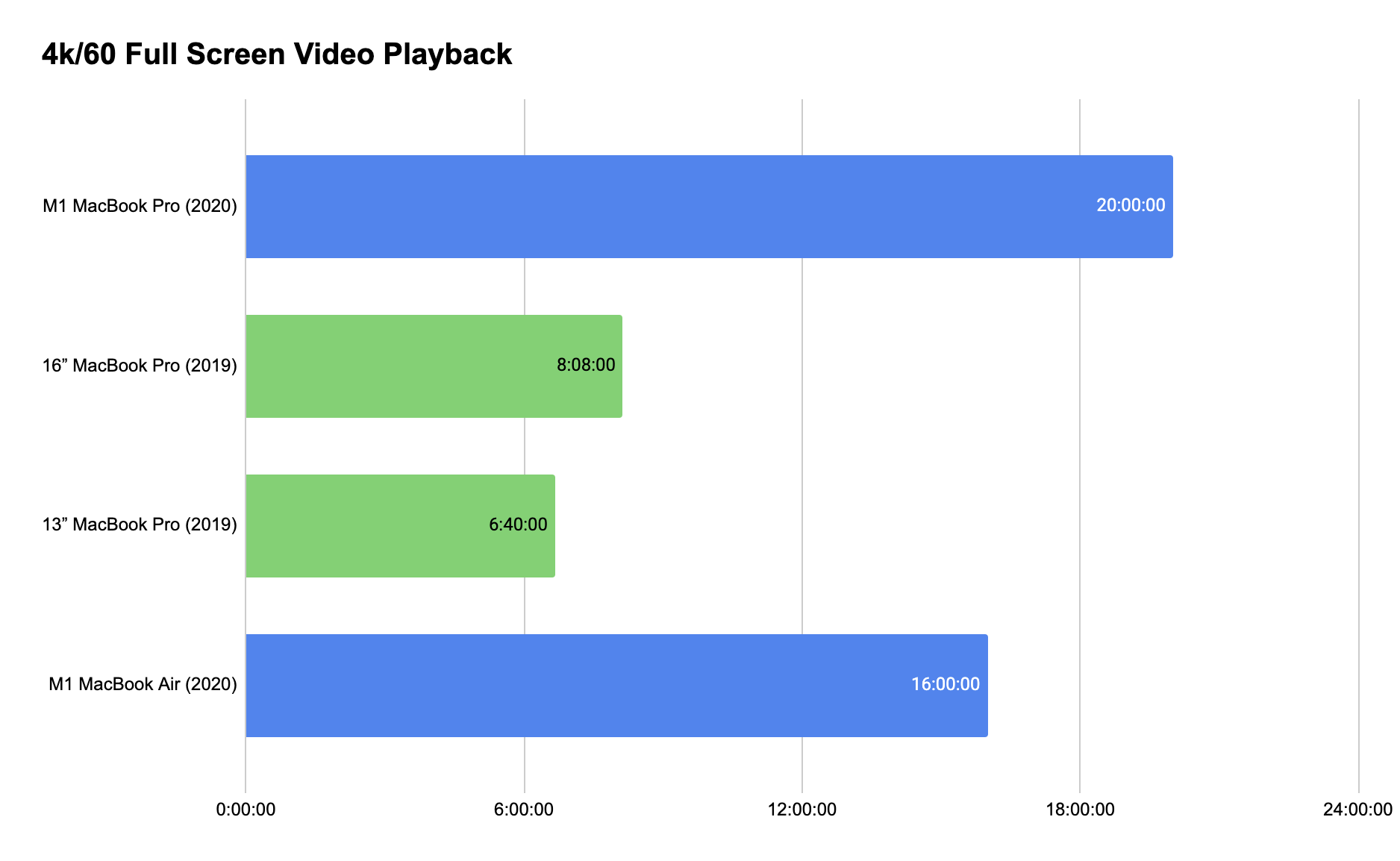
These three new systems represent the first step toward Mac’s future. And there’s a lot to be excited about when it comes to the potential of Apple Silicon. The M1 chip already displays some pretty dramatic performance gains for a lot of tasks, coupled with substantial increases in battery life, courtesy of decreased power consumption.
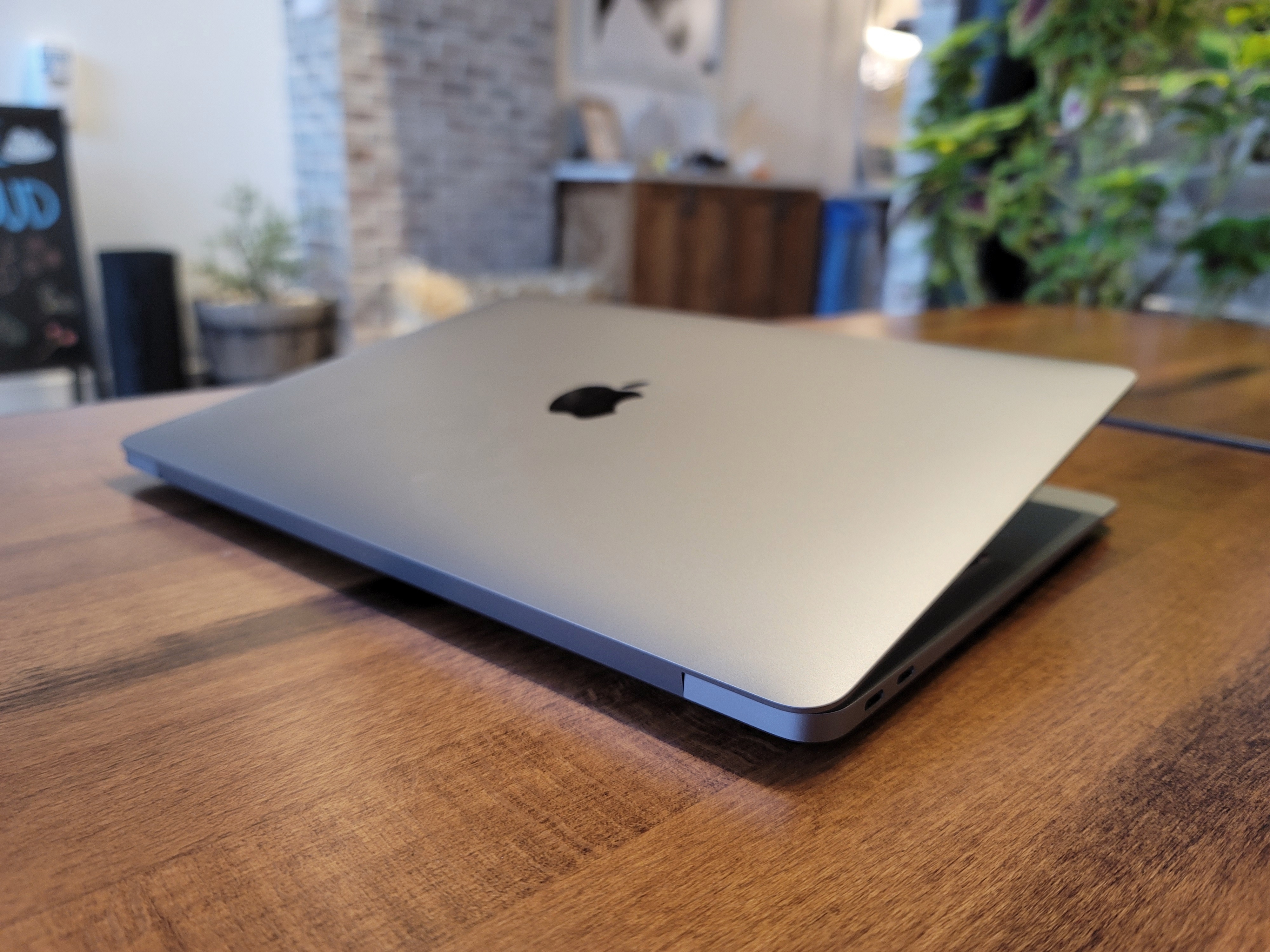
Image Credits: Brian Heater
There are some limitations worth noting on these models. Two USB-C ports appears to be the maximum in the current configuration and all three models currently top out at 16GB of RAM. If either of those are dealbreakers, the company will happily still sell you an Intel model for the foreseeable future.
When Apple Silicon was announced at WWDC back in June, Tim Cook noted that it would take two years to transition the full line. That means we’re very much at the beginning of this journey and there’s a lot left to reveal, including how dramatically different the true Pro tier of MacBooks look.
For most users with most needs, the Air is a fine choice. If I had to buy a new MacBook today I would pull the trigger on Air and upgrade the memory and storage for good measure. It’s a surprisingly powerful machine in a compact package.
"right" - Google News
November 17, 2020 at 09:03PM
https://ift.tt/38NKcLS
MacBook Air M1 review: The right Apple Silicon Mac for most - TechCrunch
"right" - Google News
https://ift.tt/32Okh02
Bagikan Berita Ini















0 Response to "MacBook Air M1 review: The right Apple Silicon Mac for most - TechCrunch"
Post a Comment